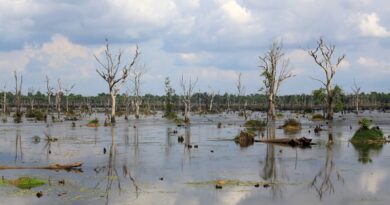NGT panel recommends revisiting 1994 water pact for Yamuna rejuvenation
A panel constituted by the NGT for monitoring of the Yamuna has recommended revisiting a water sharing agreement inked in 1994 between Uttarakhand, Himachal Pradesh, Uttar Pradesh, Haryana and Delhi to ensure environmental flow in the river throughout the year.
The Yamuna, a tributary of the Ganga, originates in Uttarakhand and flows through the five states before it meet the Ganga.
The panel, which has two members – former NGT expert member BS Sajawan and former Delhi Chief Secretary Shailaja Chandra – made the recommendation on the basis of a draft report on ‘e-flow for the Delhi stretch of the river’ prepared by Roorkee-based National Institute of Hydrology.
“The Ministry of Jal Shakti, Upper Yamuna River Board and the riparian states of Uttarakhand, Himachal Pradesh, Uttar Pradesh, Haryana and Delhi (should) rework the 1994 water sharing agreement to permit release of the recommended e-flow at Hathnikund Barrage,” the panel said.
The NIH report had recommended that 23 cumec water be released in Yamuna from the Hathnikund Barrage in Yamuna Nagar district in Haryana instead of 10 cumec in January and February for sustaining downstream ecosystems.
The barrage regulates the flow of the river for irrigation in Haryana and Uttar Pradesh through western and eastern Yamuna canals and municipal water supply to Delhi.
The report said 26 cumec, 29 cumec, 34 cumec and 44 cumec water should be released in the river in March, April, May and June, respectively. At present, 10 cumec is being released in the river in March, April and May and 18 cumec in June, according to news reports.
A minimum release of 158 cumec, 220 cumec and 149 cumec is recommended in July, August and September instead of 275 cumec, 298 cumec and 160 cumec, the NIH report said.
Based on the report, the panel said the Ministry of Jal Shakti, Upper Yamuna River Board and the riparian states should ensure release of 44 cumec, 27 cumec and 24 cumec water in the river from the barrage in October, November and December.
Meanwhile, the green tribunal has tasked Uttar Pradesh Chief Secretary to ensure coordination for rejuvenation of the Hindon, another tributary of the Ganga.
The Hindon is one of the polluted river stretches and no meaningful action has been being taken to clean it, the NGT said, adding that effective steps should be taken for restoration of its water quality instead of blame game.
“The river is practically dead and needs to be restored in the interest of the environment and public health. Meaningful progress must be achieved by the concerned departments including the Urban Development, Irrigation, Jal Nigam, and the Environment,” a bench headed by NGT chairperson Justice A K Goel said.
All drains joining Kali, Krishna and Hindon should have in-situ remediation and plan for connectivity with the identified sewage treatment plant. “The Chief Secretary may ensure that there is coordination among all the concerned departments in accordance with the action plan prepared by a committee headed by former high court judge Justice SU Khan”, the bench said.
In a separate hearing, the NGT has also directed UP Jal Nigam to complete the work of sewer connectivity to households at Narora town in Bulandshahr district expeditiously to ensure that no untreated water gets discharged into the Ganga.
Coming down hard on the UP Jal Nigam over non-functional sewage treatment plant at Narora and discharge of untreated sewage in a pond adjacent to the river, the NGT said the agency is held liable to pay Rs 5 lakh for its default, which may be deposited with the state pollution control board within one month to be spent for restoration of the environment.
“UP Jal Nigam must perform its responsibility and cannot take the plea that fault was of the contractor. The work of sewer connectivity to households be completed expeditiously which may be reviewed by the Principal Secretary – Urban Development,” the NGT said.


